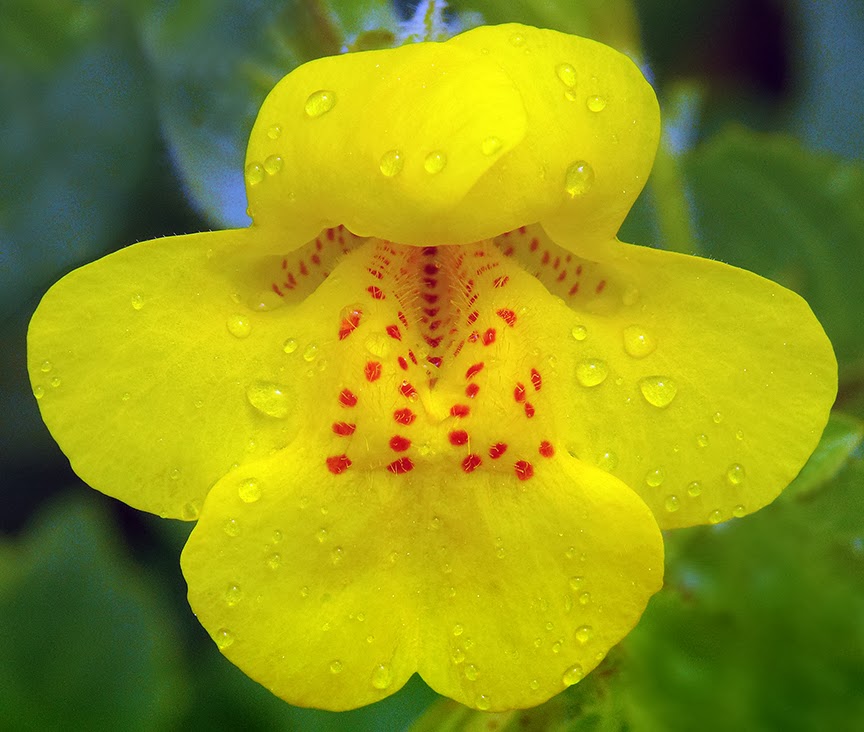Genomic variation is a feature of all natural populations and is vitally important in order to survive changes in their environments. Genetic variation among individuals, to which DNA recombination is an important contributor, is passed from parents to offspring and helps explain that different individuals in the population may harbor a diverse set of traits. Understanding and characterizing this variation requires both appropriate model organisms and a considerable amount of genomic sequencing capacity, on the scale of the capability of the U.S. Department of Energy Joint Genome Institute (DOE JGI).
Published the week of November 11, 2013 in the journal Proceedings of the National Academy of Science (PNAS), a group of researchers led by the DOE JGI completed a draft sequence of the monkeyflower (Mimulus guttatus) genome and identified the historic footprints of DNA recombination events that have shaped the development of this plant species over the last several hundred thousand years. By extension, these observations should inform new plant breeding strategies that could be vitally important to developing improved bioenergy plant feedstocks.
The genus Mimulus is commonly known as the monkey flower because of its resemblance to a scrunched up monkey face (Mimulus derives from the Latin for “mime”). The flower is a near cousin to the oft-domesticated snapdragon.

Mimulus guttatus, the yellow monkey flower. Image by James Gaither
Uffe Hellsten, an astrophysicist-turned computational scientist in the Plant Genomics Group at the DOE JGI and first author on the PNAS paper said that he and his colleagues traced some 400,000 events that took place within a wild population of Mimulus guttatus.
“We were able to accomplish this by a novel method of analysis developed at the JGI involving sequencing of pooled DNA from the population and aligning these sequences to a Mimulus reference assembly,” Hellsten said. Both the reference assembly and the population genetic analysis are published in the PNAS paper. “This analysis allows us to pinpoint very accurately, down to a few letters of genetic code, the variation of recombination across the genome, and demonstrate that recombination is enhanced near starts of genes.” Regions of high recombination activity are dubbed “hotspots.”
Recombination events in monkey flower (and the team presumed plants in general) work the same way they do in yeast but unlike those in mammals, where hotspots are heavily influenced by the presence of binding sites for a particular recently-evolved protein (PRDM9). This approach achieved an unprecedented resolution by exploiting the presence of a large number of “SNPs” (single nucleotide polymorphisms), which are single nucleotide (a letter of the genetic code) changes between the DNA sequences of different individuals. On average, monkey flower has one change every 35 letters. This is in stark contrast to human genomes, where only about one in 1,000 nucleotides differ. These SNPs can provide genomic signposts to precisely locate past recombination events so that they can be correlated with heritable differences between individuals. Understanding these correlations in Mimulus guttatus will shed light onto the biology of other plants, including bioenergy crops.
“This high resolution allows us to find that hot and cold spots vary within a few hundreds or thousand bases,” Hellsten said. “While cold spots appear to be entirely devoid of recombination, hot spots display a spectrum of ‘temperatures,’ ranging from ‘lukewarm,’ which are common in the genome, to increasingly hotter in less common regions. We found that recombination events occur much more commonly close to the beginnings of genes and that more than 25% of the genome consists of cold spots, which don’t participate in recombination at all, are inherited as unshuffled blocks from parents.”
Since Darwin’s days, Mimulus has been a leading model system for studying ecological and evolutionary genetics in nature. The genus Mimulus ranges widely in floral morphology (and associated pollinators), mating systems (self-pollinating to outcrossing), as well as growth forms (annual herbs to perennial woody shrubs). Like all plant genetic model systems, Mimulus species have a small genome (about 430 million base pairs), a short generation time (6 to 12 weeks), high fecundity (100 to 2,000 seeds per pollination), and are easy to propagate in the greenhouse. Unlike most plant genetic model systems; however, the ecology of Mimulus is known in great detail due to prominent field-based research efforts.
Northern California, home to the DOE JGI, is the worldwide center of biodiversity for Mimulus species. Its growth habit is extremely diverse—from barely noticeable, a half-inch small growing in austere sandy soil on the side of a high-Sierra trail with flowers no bigger than the head of a pin, to vigorous plants thriving in seeps of springs rising to nearly three feet tall with flowers the size of a infant’s fist. Colors range from radiant yellows and oranges to pink and scarlet. Flowers often are decorated with spotted or stripped “bee lines” to provide landing pads for prospective pollinators.
“The DOE JGI Mimulus reference genome provides a valuable service to the research community because it enables the identification of the genes and other important features of the genome structure, such as regulatory and repeated elements, that might contribute to its evolutionary and ecological diversity,” said John Willis, a long-time DOE JGI collaborator from Duke University and co-author of the PNAS paper. “Now that Mimulus is officially published as a reference genome, we should see an avalanche of publications from other research groups capitalizing on the genomic infrastructure that we have provided,” he said.
“With this reference, we’ll be extending Mimulus’ role as an important genetic model to gain additional insights that should be generally applicable to many plants, ultimately helping with crop improvement strategies for important agricultural and biomass-for-biofuels crops,” said Hellsten.
Additional contributors to the research and the publication were from the Hudson-Alpha Institute of Biotechnology, Harvard University, University of Connecticut, and the University of California, Riverside.
The Mimulus guttatus draft genome is publicly available at the DOE Joint Genome Institute’s plant data repository, Phytozome: http://www.phytozome.net/mimulus.php.